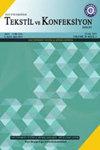可生物降解PCL纳米纤维垫的镀铜
IF 0.7
4区 工程技术
Q4 MATERIALS SCIENCE, TEXTILES
引用次数: 0
摘要
在这项研究中,可生物降解的聚己内酯(PCL)纳米纤维在一个更环保的镀液中电镀铜(Cu),与传统的电镀镀液相比。阐述了镀铜机理及制备镀铜PCL纳米纤维垫的最佳工艺参数的确定。采用静电纺丝的方法在金属骨架上制备了PCL纳米纤维。镀铜需要导电表面。为此,在不同溅射厚度的PCL样品上溅射了金/钯混合物。确定最小溅射厚度后,分别在电镀槽中镀铜1分钟、3分钟、5分钟和30分钟。分别对制备纳米纤维、Au/Pd溅射和电镀后样品的表面性能进行了评价。电镀后还进行了元素分析、绘图和电学表征。铜涂层区域的片电阻在毫欧姆范围内,表明具有高导电性结构。研究的每一步都被详细描述,为进一步的研究提供见解。本文章由计算机程序翻译,如有差异,请以英文原文为准。
Copper-Electroplating of Biodegradable PCL Nanofiber Mats
In this study, biodegradable polycaprolactone (PCL) nanofibers were copper (Cu) electroplated in a more environmentally friendly bath compared to conventional electroplating baths. The Cu-plating mechanism and determination of the optimum parameters for the production of Cu-plated PCL nanofiber mats were explained. PCL nanofibers were produced on metal frames by electrospinning. Cu-electroplating needs a conductive surface. To provide this, a gold/palladium mixing was sputtered on the PCL samples with different sputtering thicknesses. After determining the minimum sputtering thickness, the samples were Cu-plated for 1,3,5 and 30 minutes in the electroplating bath. Surface properties of the samples were evaluated after nanofiber production, Au/Pd sputtering and electroplating, respectively. Elemental analyses, mapping and electrical characterizations were also performed after electroplating. The Cu-coated areas gave a sheet resistance in the range of milliohms indicating a highly conductive structure. Every step of the study is described in detail to provide insight for further studies.
求助全文
通过发布文献求助,成功后即可免费获取论文全文。
去求助
来源期刊

Tekstil Ve Konfeksiyon
工程技术-材料科学:纺织
CiteScore
1.40
自引率
33.30%
发文量
41
审稿时长
>12 weeks
期刊介绍:
Tekstil ve Konfeksiyon, publishes papers on both fundamental and applied research in various branches of apparel and textile technology and allied areas such as production and properties of natural and synthetic fibers, yarns and fabrics, technical textiles, finishing applications, garment technology, analysis, testing, and quality control.
 求助内容:
求助内容: 应助结果提醒方式:
应助结果提醒方式:


